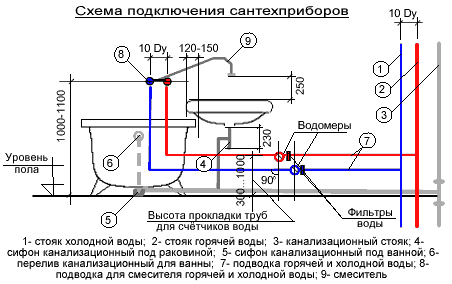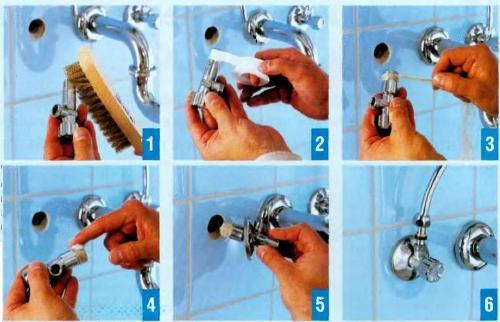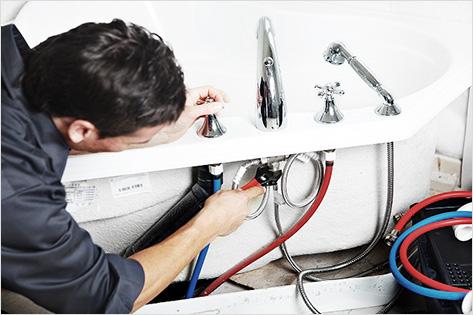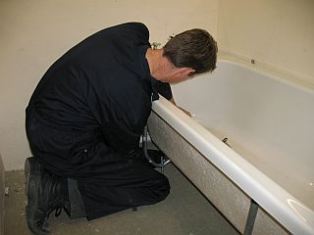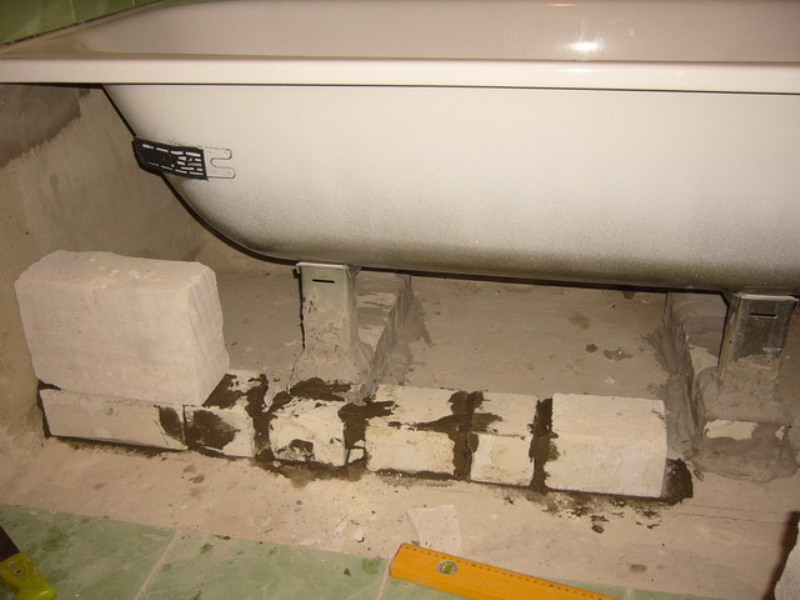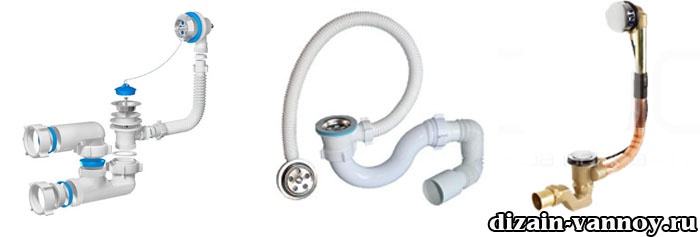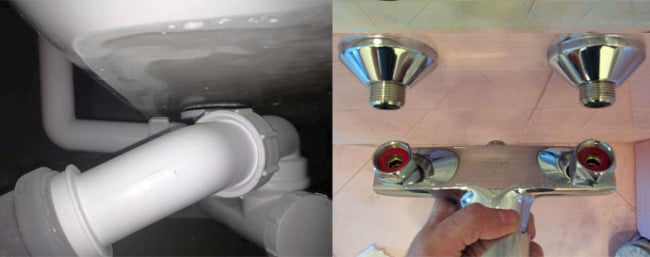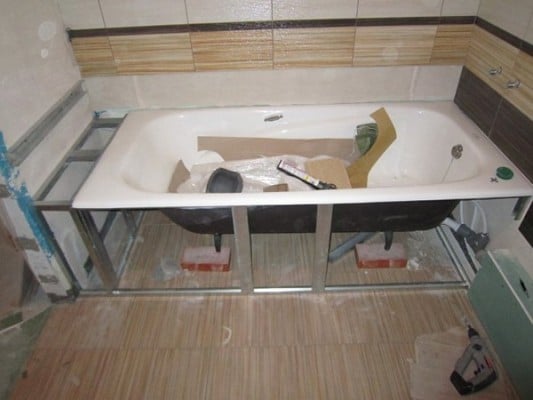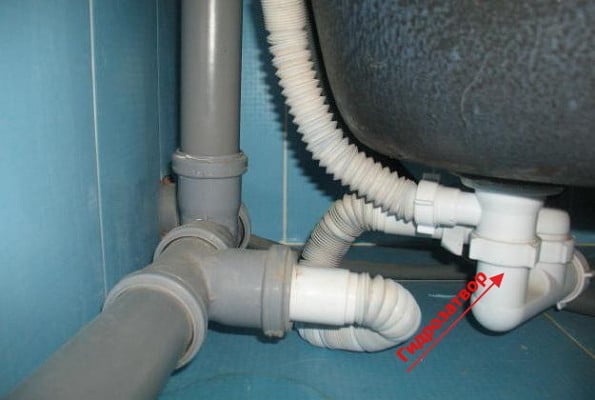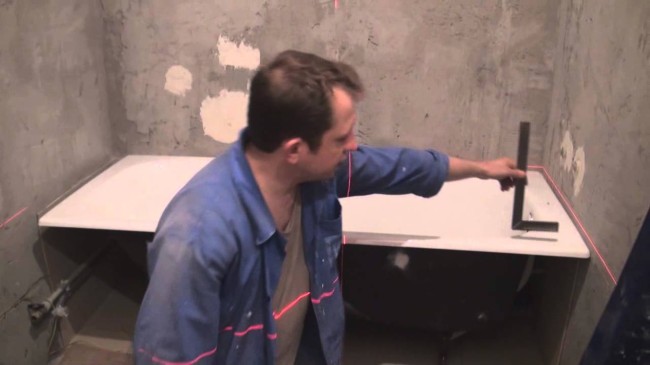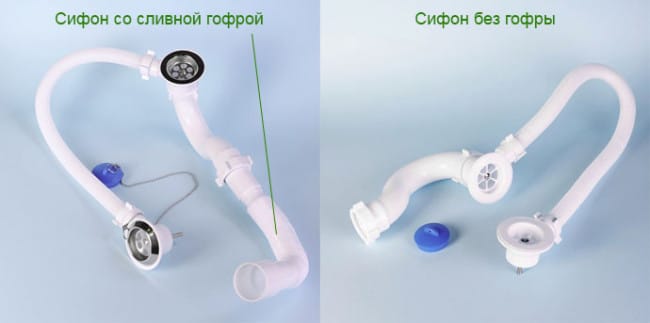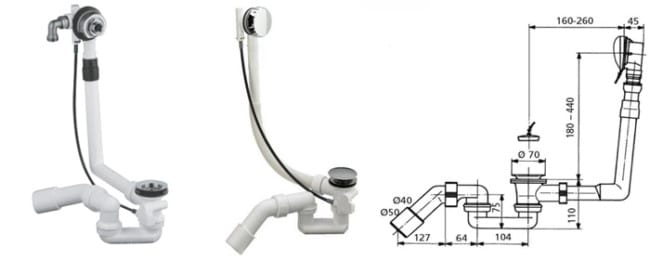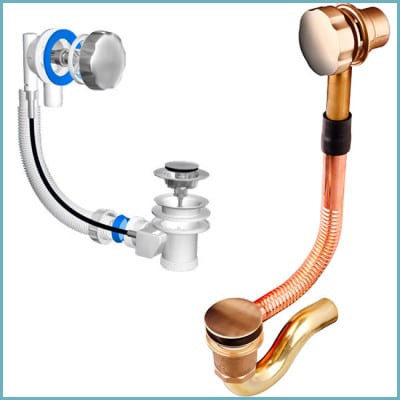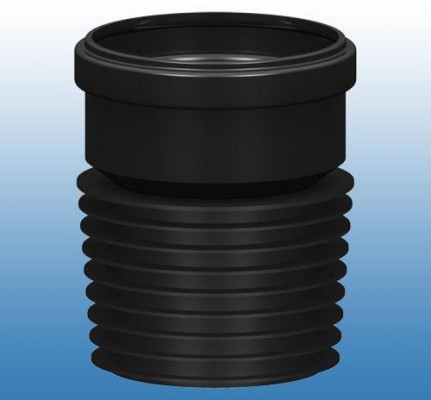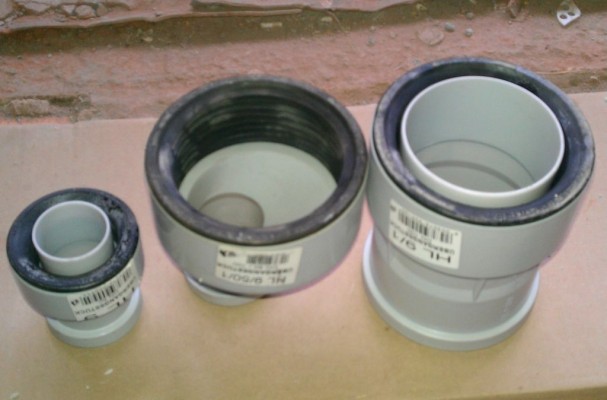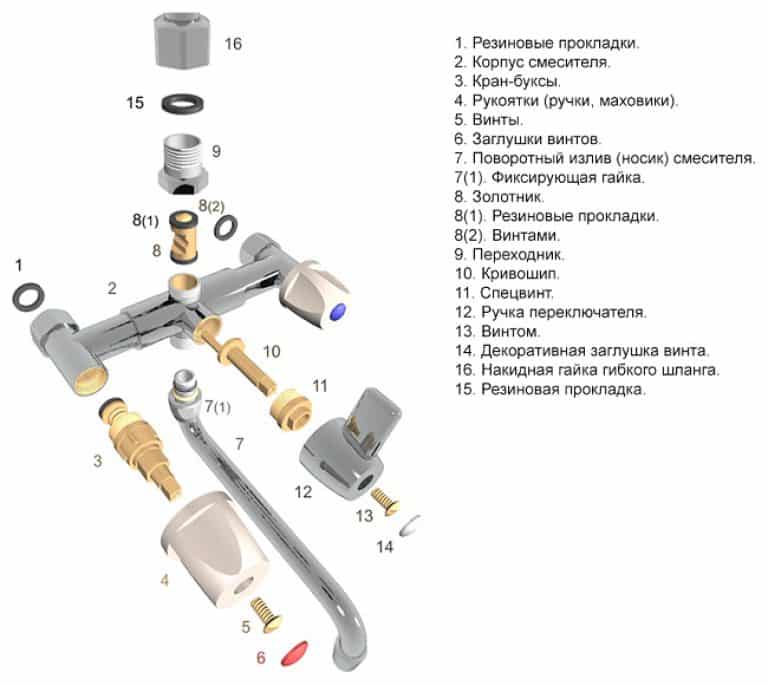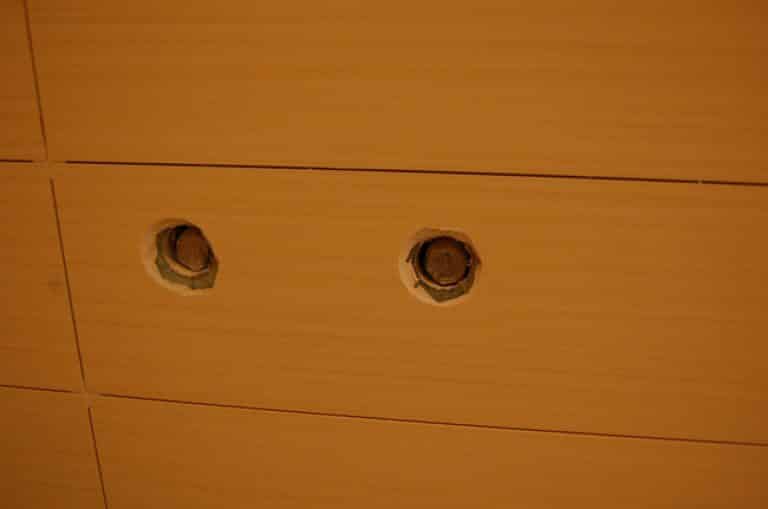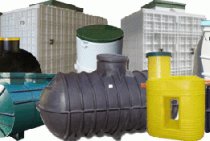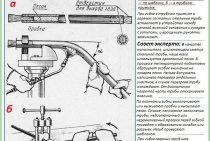Sewer design
At the initial stage of creating a sewer system, marking work is carried out. A diagram of the location of all plumbing that is connected to the sewer is drawn on paper. The place of laying pipes is determined and the need for material is calculated.
In the course of measurements and calculations, the following features should be taken into account:
- The pipes are connected using tees with different outlets or funnel-shaped adapters.
- Of particular difficulty will be the laying of pipes under the bath. In order not to waste time removing the bath, the pipes are connected from several elements.
- If you plan to connect the sink and bathtub at the same time, then the sewer wiring is performed using a tee. The third outlet can be tilted 45º or 90º from the axis of the pipes.
- To connect the siphon to the sewer pipe, a branch pipe with an angle of rotation of 90º is used.
If the installation of some kind of plumbing that requires draining is planned in the future, then a tap is necessarily created for it. It is easier to close the pipe with a temporary plug (although this is not attractive) than to re-install the sewer system.
Bath connection technology
The procedure for connecting the bath to the sewer system
The connection order is as follows:
Assemble the siphon in accordance with the instructions attached to it, paying special attention to all necessary sealing gaskets.
Plastic fasteners are twisted by hand, while acting very carefully. Tools are not used, as their use can break the part.
After the device has been mounted, one end of the pipe is attached to it, and its other end is brought to the sewer drain hole and the connection is made.
The connection of the bathtub drain must be accompanied by careful control of the density of the assembled joints in order to ensure a high degree of their tightness.
Pro tip:
Pro tip:
If the slightest malfunctions are detected, they must be immediately eliminated, otherwise, during operation, it will be necessary to replace the defective elements of the system.
- When the sides of the bathtub tightly adjoin the walls, the joints must be carefully sealed so that water cannot penetrate under the bathtub.
Connecting the bath to the water supply
As well as connecting the bath with your own hands to the sewer, it is also possible to independently connect to the water supply and install a mixer. You don't need to call a plumber for this.
Consider this technology:
- A stopcock is installed on the pipe in front of the fittings, the presence of which is necessary to shut off the water when replacing the mixer or in case of repair.
- Eccentrics are attached to the fittings located on the mixer (first by hand, and then they strengthen the fixation with a key). In this case, a FUM tape or a specialized thread is used, designed to connect elements of the plumbing system.
- Decorative nozzles are put on eccentrics.
- Rubber or silicone gaskets are inserted on the mixer inside the thread, and then the mixer is screwed to the eccentrics (in this case, it is not necessary to use FUM tape or thread).
Pro tip:
The bath connection diagram must necessarily include a check of the quality of the work performed - if leaks are found in the mixer, the gasket is replaced - it is possible that the leak occurred due to a defective gasket.
- The mixer is screwed simultaneously from 2 sides. In this case, uniform sealing of the gaskets occurs.
- If a mixer is included with the purchase of the bathtub:
- then the permissible level of the height of the pipes is below the level of the bathroom, since in this case the connection is made using reinforced hoses;
- at the same time, it is not necessary to align the ends of the pipes - such hoses are very plastic;
- the basic rule in this situation is to make sure that the length of the reinforced hose is slightly longer than the distance from the tub to the end of the pipe.
After carrying out all the operations to connect the bath to the water supply and sewerage, turn on the water and observe if there are any leaks. If there are leaks, then you need to make sure that the gaskets are well fixed, and also make sure the quality of the gaskets themselves (if they are of poor quality, you will have to replace them).
The implementation of such simple rules will allow you to qualitatively connect the bathroom to the sewer and install the mixer correctly. With this approach, the bath will last for many years!
Pipe selection criteria
The main technical characteristic of plastic pipes is their diameter. It is worth mentioning right away that in most cases, manufacturers mark pipes based on the size of the outer diameter.
For sewage, the main parameter is the inner diameter. The purchase of pipes of a certain diameter is carried out depending on the type of plumbing. In particular, the minimum pipe diameter is:
- for washing and dishwasher - 25 mm;
- for bidet and sink - 32 mm;
- for a shower or bath - 50 mm;
- for several devices connected to one outlet - 70 mm;
- for the toilet and the main riser in the apartment - 100 mm.
The second parameter that is taken into account when purchasing sewer pipes for the bathroom is the length of the products. On sale there are pipes from 1 to 6 m long. It is most convenient to work with material that has a length of 2 or 3 m.
When calculating the required footage of plastic pipes, it should also be taken into account that they are equipped with sockets with sealing rubber bands, which are designed to tightly connect adjacent elements.
System leak test
After completion of the installation, the sewerage in the bathroom and toilet must be tested for tightness. First, close the drain hole and fill the bathroom with water by about 2/3 of its volume. Within 15 minutes, we observe the lower drain hole of the siphon for leakage. If there are no leaks, then the bathroom is full to check the tightness of the overflow hole. At this stage, the sewer in the bathroom is checked for leaks with a small amount of liquid.
At the final stage, open the bottom hole of the siphon and check the operation of the sewer with a large amount of fluid under pressure. The diameter of the sewer pipe for the bathroom should not be less than the diameter of the drain hole.
Before sewing in the bathroom, it is necessary to check the quality of the plastic from which the siphon is made for high temperature tolerance. Sometimes there are low-quality products on the market that, when a hot liquid passes through them, begin to deform, and in this case, it is necessary to replace the drain pipe in the bathroom with a new one. You can check the quality of the pipes by pouring hot water from the kettle into the siphon.
Comments:
Connecting the bath to the sewer on your own
Many of us believe that the most difficult process is the installation of a purchased bath. But in fact, the main difficulties are caused by connecting the bath to the sewer, since the safety of the room from leaks depends on the quality of the work.
Indeed, a dripping faucet will not cause as much harm as a leaking siphon under a bathtub or a fistula in a sewer riser. And the situation when the bathroom smells of sewage gives special trouble to residents. Let's deal with these and other problems together.
Bath connection process
Most often, new bathtubs get a set consisting of:
- Siphon and connecting pipes;
- Drain-overflow systems.
In most cases, this is a single unit that has its own installation features:
- On acrylic bathtubs, due to the pre-assembly of the power frame, the siphon is installed immediately (on an inverted bathtub);
- The siphon is connected to cast-iron and steel bathtubs after their installation.
Reference:
Installing steel baths on a brick base narrows the work space. Therefore, experienced plumbers pre-install individual components on the bath.
Advice:
Your main task is to make all connections airtight. When installing a bottle siphon, special gaskets are always included in the kit, which are mandatory for use.
We arm ourselves with the assembly scheme and proceed:
- First, we install a drain-overflow on the bath, because. after installing it close to the wall, this will be problematic;
- After installing the bath in place and fixing, we assemble the receiving unit (bell with a pipe and a protective mesh). We put a gasket on the edge of the socket, insert it into the drain hole of the bath and from below, also with a gasket and a nut, we connect the parts into a single unit. Depending on the design, the mesh can either be screwed on or removable;
- The turn of the assembly of the siphon came up. We collect the glass according to the attached diagram and attach it to the protruding branch pipe of the receiving unit. We fix it with a plastic nut, tightening it with our hands;
- Do not forget to attach the drain hose of the overflow drain system - we put its end on a special layer;
- From the siphon into the sewer tee, we insert a corrugated pipe or a plastic one using rubber adapters.
Advice:
adapters play the role of a seal that allows you to securely seal the entire structure.
Conclusions:
we are sure that now you know almost everything about sewerage and how to connect a bath. It remains only to apply the acquired knowledge in practice, and spend the money saved at work on the purchase of stylish bathroom accessories.
The arrangement of the bathroom implies the mandatory connection of the bath to the sewer and water supply. These plumbing works are easy to do with your own hands, even without prior experience.
Operating principle
First, let's look at how the sewage works in the bathroom:
- The bath, filled to the brim, dumps part of the water through the drain-overflow system;
- When the drain hole is opened, the water from the bath enters the siphon;
- Bypassing the water seal, wastewater passes through a sewer pipe (hose) connected to a tee;
- Through the sewer tee, wastewater enters the riser.
Materials of past years
A couple of decades ago, when there was no heyday of PVC products, all sewers were assembled from cast iron. In particular:
- Siphons and intake pipes;
- Washbasin elbow;
- Tee of the apartment sewer pipe;
- Inspection window on the riser;
- The stand itself is in the apartment.
And for the tightness of the connection, in addition to the traditional tow, the following were used:
- cement mortar;
- Liquid glass
- Epoxy adhesive
- Rubber, etc.
Modern materials
But with the advent of the era of plastic, everything has changed. Today, almost any adult man can assemble and connect a sewer siphon.
Sewer connection
In any bathroom, there is already a drain for sewerage, but in private self-builds this may not be the case. If this is your case, then before installing the bath, you need to drill three holes in the floor - for sewerage, hot and cold water. Further, the corresponding pipes are connected to them. Only after this is the plumbing fixture installed.
Step-by-step instructions on how to connect the bath to the sewer:
A corrugation and a siphon are used to connect the sewer outlet and the bath
Before installing them, it is important to check the level of the bath, the location of the drain pipe and its diameter. Only after that the necessary plumbing details are selected;
Overflows are installed first
There are two of them - through passage (through, central) and shut-off. Through is mounted in the drain of the bath, and locking in the side end. Before installing a through overflow, you need to assemble the siphon;
Assembling a siphon with your own hands is very simple. A black rubber gasket is inserted into the structure itself. A nut is installed in the central overflow, it must be pushed into the hole by 3–4 mm. After you need to press the gasket in the siphon. For this, an overflow is screwed into it.
Please note that plastic threads do not need to be sealed, so FUM tape is not used. Next, the output to the corrugation is set
It is mounted in the upper part of the siphon, above the water lock, a cone gasket must be installed on this pipe. It is pressed with a plastic nut;
There are two corrugations in the bath: drain and sewer. The drain has a small diameter, it is installed on the side overflow. This corrugation is also connected to the siphon with a gasket and a nut. The sewer corrugation is also connected by a threaded method with a nut, and the overflow is similarly fastened;
Each siphon has a cleaning hole, which is closed with a solid nut. The connection must be sealed with a rubber gasket (white or yellowish). This is necessary for urgent repairs when the drain is clogged;
If you have a plastic pipe to exit the sewer, then most likely it already has a gasket. If not, you need to additionally seal the mount. To connect a plastic sewer corrugation from a bathtub to a cast-iron or other pipe, you will need a special adapter;
After completing the collection of the siphon constructor, you need to check how it will be installed. Overflows are installed in the intended places. To do this, a double elastic band is placed in the central hole of the bath, and a single thin one in the side hole. Next, a siphon is installed and tins are attached to the holes. With the help of a bolt, the mesh takes root. A transitional overflow is also attached;
To connect the sewer and corrugations, the side surfaces are lubricated with silicone sealant or soap. This will make it easier to connect the pipes. After they are additionally treated with a sealant. It is desirable to stretch the corrugations without kinks, otherwise water will not pass through them well.
This completes the process of connecting the bath to the sewer. Check the connection points of the siphon and overflows - water should not drip from them. The described method is the simplest and most affordable. Connecting brass structures is done in a similar way, but such siphons are 3 times more expensive than plastic ones.
Video: How to connect a bath to a sewer
Problems with the construction of the sewer system
old pipes
In the course of work on the sewerage device, a number of problems can be encountered. For example, at the stage of dismantling, you may encounter old pipes "tightly" fixed to the wall. This is especially true for residents of old apartment buildings. In this case, you need to carefully remove the old finish so as not to damage the elements of the general sewer system.
Correct slope
When laying new pipes, the slope, which we have already mentioned, must be observed. But the fact is that during the installation work, the structure being created is subjected to a slight displacement. To prevent this process, you should use clamps with latches.
Leaks
Another problem is the presence of a continuous leak as a result of testing and reconnecting the pipe to the fitting. In this case, an adhesive-based sealant is used. It is applied to the joints. The rubber band is inserted into the fitting. After drying, the sewer system is tested again.
Smell
A fairly common problem for the bathroom is an unpleasant smell. It can be caused by various reasons:
- lack of water in the water seal;
- damage to the sewer pipe;
- deterioration of the tightness of the pipe and drain connections;
- accumulation of debris at the bottom of the siphon.
Lack of water in the water seal
The first reason for the lack of water in the water seal may be a poorly installed pipe in the siphon. The pipe simply does not reach the water, and the smell passes by it. This problem is solved by lowering the nozzle 2-3 cm into the water.
Sagging corrugated pipe.
This defect could occur if the pipe is not secured with spacers or electrical tape.
Prolonged non-use of the bathroom is also one of the factors that cause unpleasant odors. The water in the siphon just evaporated. To remove an unpleasant odor, turn on the water and ventilate the room.
Damage, deterioration of tightness and blockage.
When a crack forms in the pipe, dirty water enters the floor and wall. As a result, stains and mold develop, which lead to the appearance of an unpleasant odor. The crack is sealed with a sealant, and the pipe is wrapped with tape. The sealant is also used to restore the tightness of the drain and pipe connections.
Cleaning the siphon from debris accumulated at the bottom is done by unscrewing the bottom of the siphon and washing it. For preventive purposes, chemical agents intended for cleaning sewers are periodically used.
The nuances of laying plastic pipes
The connection of two adjacent pipes is carried out using a fitting. More precisely, the hermetic fixation of the pipe occurs in the rubber band of the fitting. The pipe must be inserted all the way
It is very important that the fitting and pipes are clean. Otherwise, over time, the sealing of the connection will be broken.
To improve the tightness of the joints, the ends of the pipes are treated with soapy water.
The most difficult process is the installation of the riser. Therefore, it is from this site that the installation of the sewer system begins. First, the tee is installed. To do this, a rubber cuff, which is pre-lubricated with a sealant, is placed in the lower socket and connected to the tee. Clamps are used to fix pipes and riser to the wall.
After assembling the riser, the pipes are led to the places where plumbing fixtures will be located. Immediately you need to provide for the presence of a slope towards the riser. It should be within 2 cm per 1 m of pipe. If sewer pipes are laid in wall strobes, then clamps are used to securely fasten them.
After installation work, all connections are carefully checked. The drain elements of plumbing are connected to pipes. This procedure is not difficult. Difficulty can only cause the connection of the bath to the sewer.
Connecting the bath to the sewer
To connect the bath to the pipes, it is better to use a siphon with overflow. Its installation requires compliance with two requirements:
- Creating an optimal height difference between the outlet and the drain pipe. The specific size of the difference depends on the height of the outlet of the siphon.
- Providing access to the siphon, which is necessary for the periodic cleaning of the weir assembly.
As for the pipe that will connect the bath to the sewer, the best option is hard plastic products. They should have two knees, which will provide optimal rotation of the elements. If it is not possible to connect the drain units with rigid pipes, then corrugated pipes are used. When joining pipes of different diameters, adapters are used.
Connecting the bath to the sewer consists of the following sequential steps:
- all rubber gaskets fit into place;
- the siphon is assembled and the overflow pipe is connected to the bath;
- fasteners are screwed in;
- with the help of a pipe and a pipe, the siphon is connected to the drain hole;
- joints are sealed at the points of contact between the bath and the wall.
The connection of all plastic elements occurs without the use of open-end or gas wrenches. The work is done manually. Otherwise, there is a risk of damage to the plastic thread.
After the completion of the installation work, a preliminary testing of the sewer system is carried out. It is necessary to turn on all plumbing fixtures and stock up on 2-3 buckets of water. When the plumbing begins to drain waste water into the system, buckets of water are poured into the sink, tub and toilet. If there are leaks, it will be necessary to redo the fastening of the sewer elements in such places.
Preparing to connect
Before laying the sewer in the bathroom, you need to prepare all the structural elements in advance, guided by the advice of specialists described below. The main element for ensuring the drain is a siphon, which makes it possible to clean the system if the sewer in the bathroom is clogged. In order not to get confused in terms when buying this product, you need to remember that this device has two more names, “strapping” or “drain-overflow system” for the bathroom.
How to choose a siphon
The drain pipe for the bathroom can be made of materials such as:
- copper;
- brass;
- cast iron;
- plastic;
- textolite.
When installing the sewer in the bathroom on your own, it is recommended to buy plastic products that do not provide for corrugated pipes and the design is rigid. Plastic is chosen because this type of material is easy to work with and does not require special tools, and plumbing in a metal or copper bathroom requires some experience.
When buying a siphon model for your bathroom, you need to consider a number of features:
installation of drain pipes in the bathroom can be carried out with two types of siphons. Universal type suitable for all bathtubs where the distance between drain and overflow does not exceed 57 cm
In bathrooms with other designs, it is necessary to purchase special siphons or they can be bundled with the bath itself from the manufacturer;
before you make a sewer in the bathroom and buy a siphon, pay attention to the thickness of the bathroom itself. On sale there are products that are designed for different wall thicknesses of the bathroom, but there are also universal models;
installation of sewage in the bathroom almost always provides for the presence of additional consumers in the form of a washing machine
For these purposes, there are special siphons with several outlets for connecting drains of third-party household appliances.
It is worth remembering that a siphon of any model and design needs regular maintenance, therefore, before hiding the sewer in the bathroom or when closing the bathroom with decorative panels, it is necessary to provide an inspection hole of sufficient size so that the sewer line in the bathroom is provided with free access. Usually in such cases, a removable panel or an opening door is provided in the place where the connection of the bath to the sewer is established.
When installing a new bathroom, the required height must be observed to ensure free outflow. The sewerage device in the bathroom provides for a difference between the lowest point of the sewer pipe and the connection point of the siphon. This difference should be 10-20 cm for the normal functioning of the system. In the absence of such a difference, the sewerage wiring in the bathroom will be filled with water or the liquid will leave very slowly.
Connecting the bathroom to the sewer
Before assembling the sewer in the bathroom on our own, for ease of understanding, we break the whole process into main points in the form of step-by-step instructions. The installation procedure is as follows:
- laying sewer pipes in the bathroom begins with checking the configuration of all the elements involved;
- further, all elements of the siphon are assembled into one structure and a liquid sealant is used to ensure better sealing of the joints. Usually, the connection diagram of the bathroom to the sewer and detailed assembly instructions are contained in the attached documents to the bathroom and siphon, so that you can carry out the installation on your own;
after the siphon is fully assembled, a sewage system is installed in the bathroom, where one end of the siphon pipe is connected to the drain hole of the bathroom, and the other to the inlet pipe of the sewage system;
at the last stage, the overflow pipe is connected
In this case, it is important to monitor the tightness of all rubber gaskets at the joints. The sewer pipe in the bathroom should not have stressed sections, this will lead to deformation and cracking of the plastic.
How to properly assemble and connect the siphon can be viewed in the video for this article.
Preparation for connection selection of materials and installation of the bath
Before you connect the bath to the water and sewer pipes, you need to prepare the materials and choose a place to fix the bowl. The main problem is to determine the correct installation height in order to correctly connect the siphon, to guess with the location of the mixer, if a model with a wall mount above the bath rim is chosen.
Scheme of installation and connection of plumbing in the bathroom
Simultaneously with the connection to the sewer, the installation of mixers is carried out
Bath installation: important points
The main conditions that should be met during installation for the correct connection of the bath:
- Correctly determine the height from the bottom to the floor.
- Align and fix the bowl with a level.
- Properly install a decorative screen.
Site selection and mounting height adjustment
Determination of the distance from the floor to the lowest point of the bottom must be carried out taking into account the height of the outlet of the sewer pipe. The second criterion is the type and depth of the siphon tank, the distance from the outlet pipe to the floor. The higher the bath is installed, the less problems will arise during installation.
Installation height is the most important condition for a successful connection
The distance in height between the pipe and the sewer drain should be at least 4-6 cm. The slope of the pipe from the outlet of the siphon to the tie-in to the riser will ensure that the water drains quickly, and the sufficient depth of the siphon will ensure that there is no unpleasant smell from the drain. Under standard conditions, it is enough to leave from the bottom of the bowl to the sewer outlet from 15 - 25 cm in height.
Leveling the bathtub with a laser level
After installation, you need to level the bath, determining the level of deviation along the horizontal upper edge. The angle lowered below the level must be raised.
Types of siphons: which one is better to choose
The choice of model and material of manufacture depends on the initial data: when installing on a new bath, you can choose almost any siphon, if it is possible to adjust the height of the bowl. When replacing an old siphon, you will have to focus on the type and height of the bowl, select the product according to measurements.
Even inexpensive models are equipped with a corrugation for connection
The main materials for the manufacture of budget siphons are polypropylene and PVC. Completely identical in appearance, the materials are radically different in performance.
Part dimensions and pipe diameter
A polypropylene kit is more expensive, but it will last a couple of years longer than a PVC siphon. The structure of the material is smooth, without roughness and pores: plaque is not deposited on the smooth walls, narrowing the internal lumen of the pipes. Propylene connecting threads are stronger than PVC threads: there is less risk of breaking fragile parts when screwing.
Functionality classification:
- Classic siphons. They are completed with a plastic or flexible tube connecting the outlet from the overflow to the drain. A simple design has the advantage of durability and the absence of mechanisms that often fail.The disadvantage is the need to close the drain with a lid before collecting water.
- semi-automatic products. In addition to the tube from the overflow to the bottom of the siphon, the siphons are equipped with a cable mechanism. The lever is located on the inside of the overflow. Turning the handle closes the drain - there is no need to use the cap on the chain and bend down to install the plug.
Automatic models - convenient, but expensive and unreliable
- Click-clack or automatic. To collect or drain water, just press the button or turn the lever - the bottom drain will automatically close.
What you need for assembly: pipes and adapters
In addition to the siphon, to connect the bath to the sewer you will need:
Sewer pipe and, if necessary, a turn. It is better to buy plastic rigid pipes. If there is no space to install a rigid wiring, you will have to mount a corrugated flexible pipe. The diameter of pipes for local sewerage is standard - 40 mm.
Flexible adapter for plastic
If the diameter of the sewer pipe differs from the diameter of the bath drain pipe, adapters must be prepared. For plastic pipe connections - a rubber corrugated sleeve 50 mm x 40 mm. In an apartment with an old cast-iron riser, you will need to install an adapter 73 mm (standard diameter of cast-iron pipes) x 40 mm.
- FUM tape, silicone for lubricating rubber seals (gaskets), moisture-resistant sealant for processing joints and bath edges, gasket repair kit.
- Knife for cutting plastic, if you need to cut a corrugated hose or pipe.
How to connect a bathtub to the plumbing
After installing the sewer connection, the mixer is mounted. With it, the bath will be connected to the water supply. Water outlets are holes in the wall to which outlets from the central riser are connected.
The best way to check is to turn on the water and take half a bath. With this pressure, all fragile connections will immediately show themselves. Detected leaky fasteners are tightened and treated with sealants.
After completing the main stage of repair work in the bathroom and purchasing plumbing, it remains to connect the bathroom to the sewer and connect to the water supply.
Choosing a place, installing a bowl.
Siphon assembly.
Connection to the outlet of the sewer pipe.
Connection to the water supply.
Checking the correct installation, tightness.
What threatens improper installation and connection
The bathroom smells like sewage - why is this happening? With such a question, plumbers are often asked by residents of apartments in which a bath or washbasin has recently been changed. And the answer is simple - errors during the installation of the siphon.
If the bathroom stinks, it means only one thing:
- Either the hydraulic shutter does not cope with its duties;
- Or there is a leaky connection between the siphon and the receiving tee, through which sewer odors enter the room.
According to experienced plumbers, it often stinks in the bathroom due to a decrease in the radius of the drain pipe from the corrugated hose from which the siphon is formed.
Reference:
The volume of water contained in it is not enough to withstand the atmospheric pressure of the public sewer. And she "presses through" the water plug, and unpleasant odors penetrate into the room.
